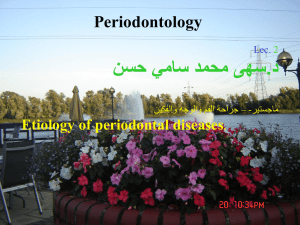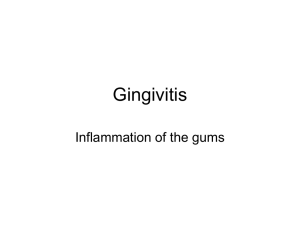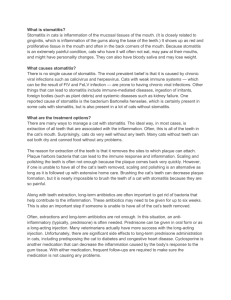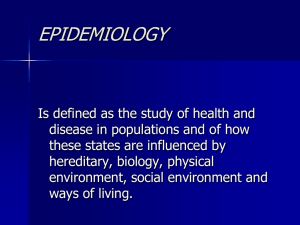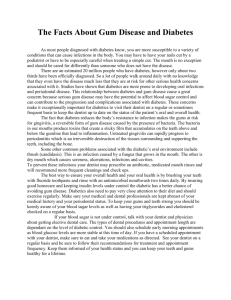GINGIVITIS AND STOMATITIS IN CATS
advertisement
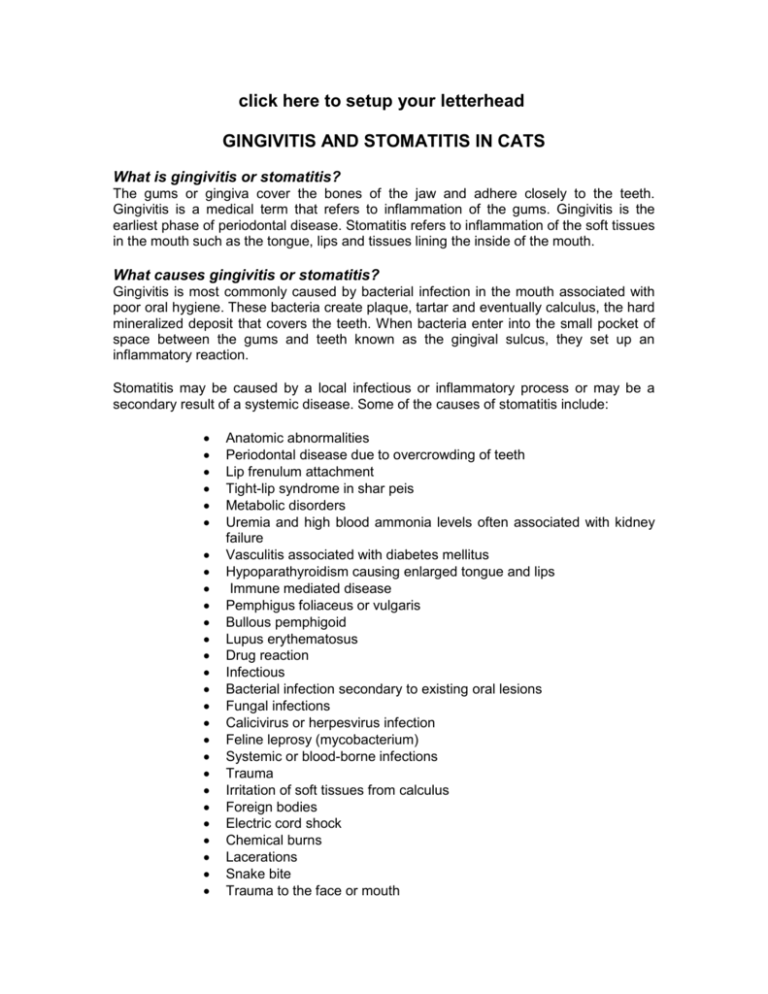
click here to setup your letterhead GINGIVITIS AND STOMATITIS IN CATS What is gingivitis or stomatitis? The gums or gingiva cover the bones of the jaw and adhere closely to the teeth. Gingivitis is a medical term that refers to inflammation of the gums. Gingivitis is the earliest phase of periodontal disease. Stomatitis refers to inflammation of the soft tissues in the mouth such as the tongue, lips and tissues lining the inside of the mouth. What causes gingivitis or stomatitis? Gingivitis is most commonly caused by bacterial infection in the mouth associated with poor oral hygiene. These bacteria create plaque, tartar and eventually calculus, the hard mineralized deposit that covers the teeth. When bacteria enter into the small pocket of space between the gums and teeth known as the gingival sulcus, they set up an inflammatory reaction. Stomatitis may be caused by a local infectious or inflammatory process or may be a secondary result of a systemic disease. Some of the causes of stomatitis include: Anatomic abnormalities Periodontal disease due to overcrowding of teeth Lip frenulum attachment Tight-lip syndrome in shar peis Metabolic disorders Uremia and high blood ammonia levels often associated with kidney failure Vasculitis associated with diabetes mellitus Hypoparathyroidism causing enlarged tongue and lips Immune mediated disease Pemphigus foliaceus or vulgaris Bullous pemphigoid Lupus erythematosus Drug reaction Infectious Bacterial infection secondary to existing oral lesions Fungal infections Calicivirus or herpesvirus infection Feline leprosy (mycobacterium) Systemic or blood-borne infections Trauma Irritation of soft tissues from calculus Foreign bodies Electric cord shock Chemical burns Lacerations Snake bite Trauma to the face or mouth Toxic Toxic plants Chemotherapy or radiation therapy Chemical irritants What are the clinical signs of gingivitis or stomatitis? The most common clinical signs associated with gingivitis include a thin red line along the margin of the gums, swollen gum margins, bad breath odor, and plaque and calculus. If the teeth are brushed, there is often bleeding from the inflamed gums. Stomatitis is generally a more severe form of inflammation than gingivitis and involves the tongue, lips and other soft tissues in and around the mouth. Some cats may have decreased appetite due to the pain of stomatitis. Additional findings may include swelling around the eyes or the tissues surrounding the mouth. How are these conditions diagnosed? Diagnosis is primarily based on medical history and clinical signs. Blood and urine tests are often recommended to look for any underlying systemic disease. Oral radiographs are often taken to determine if there is any damage to the tooth roots and support structures. Cultures and biopsy samples may be taken in severe or suspicious cases. How is gingivitis or stomatitis treated? A dental prophylaxis or cleaning is the first step in treatment for gingivitis. Any large deposits of calculus are removed, the tooth surfaces are scaled with dental instruments, and the tooth surfaces are polished. The tissues beneath the gum line are carefully cleaned to remove any accumulated plaque or calculus. Antibiotics, oral rinses containing chlorhexidine, and other home care treatments including regular tooth brushing may be recommended based on your cat’s needs. Home care is directed at reducing the plaque accumulation that leads to gingivitis. The treatment of stomatitis involves treating the underlying cause of the problem. Many cats will receive broadspectrum antibiotics, chlorhexidine rinses or gels and anti-inflammatory medications. Your cat’s treatment will be determined by the specific cause and severity of the condition. What is the prognosis for gingivitis or stomatitis? The prognosis for uncomplicated gingivitis is excellent provided you follow your veterinarian’s instructions. Most cats will benefit tremendously from a dental cleaning and polishing followed with routine home oral care. The prognosis for stomatitis is determined by the underlying cause. Most cases of stomatitis are uncomplicated and respond well to medical treatment. Your veterinarian will provide you with a more specific prognosis based on your cat’s diagnosis. This client information sheet is based on material written by Ernest Ward, DVM © Copyright 2005 Lifelearn Inc. Used with permission under license. February 16, 2016
